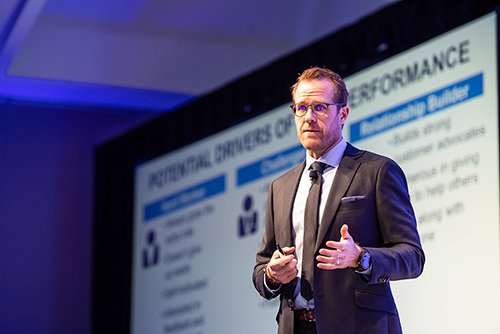Flipping the Sales Pitch at AVIXA’s AV Executive Conference

If there was an unspoken theme for the 2018 AV Executive Conference, it may have been “Reframing the Conversation.” Not only was “Reframe” one of the key elements of the opening keynote by Matt Dixon (pictured), Chief Product and Research Officer for Tethr and co-author of The Challenger Sale: Taking Control of the Customer Conversation, it seemed to be a concept on everyone’s mind.
We’ve known for a long time that the AV customer is changing, with decision makers now more likely to be in the C-suite or in that brave new world of marketing and branding agencies tasked with delivering “experiences” for your clients. The question is, how do we talk to these people, and how do AV designers and integrators fit into the conversation?
That’s where the reframe comes in. We’ve been told to put the customer first and ask about pain points in a quest to establish user needs before we even mention technology. That’s definitely important, but in the age of “busy,” lots of customers don’t have a lot of time for endless meetings where they search their souls for pain. According to Dixon, buyers and decision makers prefer to be presented with surprisingly accurate insight into their needs, preferably from your unique standpoint as a professional who works with similar enterprises to theirs.
Today, it’s the insight we bring from the field that makes us most valuable in a sales pitch, not the fact that we have a million locations or endless inventory. If you can surprise a customer with a piece of information or a blindspot in their workflow, says Dixon, you will stand out from the rest of the pack and demonstrate why your company is unique and the right one to buy from.
Maybe this sounds like a reframe, and maybe it sounds like business as usual to some. Because AV executives are natural challengers. In fact, Dixon pointed out that the challenger type is similar to the founder type, which of course is the main type of leader in our field. The only problem is how to translate that same powerful engagement and questioning tendency of the entrepreneur to other sales people on the team.
A possible answer on extending the reframe comes from another session at AVEC, the retail breakout panel in the “Emphasis on Experience Creation” track. In a conversation about the high-design ideals of retail clients, Emily Webster, Head of Media Architecture with ESI Design, suggested that AV designers “work backward” from the space to determine technology. This means not only letting the room or venue dictate what AV solutions are required, but also the overall experience sought by the client.
Ask questions to figure out “the piece that’s really engaging their market,” Webster explains, and create an environment that provides that experience. She also prescribes a modular approach to software and hardware for the ever-changing retail environment, allowing the client to change elements of AV and content quickly and easily. This may include that bold new frontier of using data and analytics to create content on the fly, designing a system that creates visualizations from information gathered by sensors or APIs. “Then the content solution isn’t such a challenge, and it’s not so hard for retailers to have dynamic spaces,” Webster observes.
Whether it was in examining the design approach or contemplating the nuances of the challenge sale, the reframe was present throughout AVEC. The top line of the conversation might be about creating experience, but the substance behind it is the technical knowledge and implementation strategies brought by AV integration experts.
Now we’re talking to customers about needs and pain points, providing valuable insight from our unique position of having numerous points of comparison on our other projects and via a network of industry colleagues. It’s the way AV has always been done, through relationship building and sharing knowledge. Only now it can lead to even more tangible experiences that will cause your customer to greatly value your ability to question and discover new ways of achieving success.






